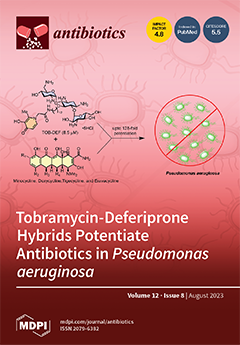Diarrheagenic
Escherichia coli (DEC) pathotypes are the leading cause of mortality and morbidity in South Asia and sub-Saharan Africa. Daily interaction between people contributes to the spreading of
Escherichia coli (
E. coli), and fomites are a common source of community-acquired bacterial infections. The spread of bacterial infectious diseases from inanimate objects to the surrounding environment and humans is a serious problem for public health, safety, and development. This study aimed to determine the prevalence and antibiotic resistance of diarrheagenic
E. coli found in toilets and kitchen cloths in the Vhembe district, South Africa. One hundred and five samples were cultured to isolate
E. coli: thirty-five samples were kitchen cloths and seventy-five samples were toilet swabs. Biochemical tests, API20E, and the VITEK
®-2 automated system were used to identify
E. coli. Pathotypes of
E. coli were characterised using Multiplex Polymerase Chain Reaction (mPCR). Nine amplified gene fragments were sequenced using partial sequencing. A total of eight antibiotics were used for the antibiotic susceptibility testing of
E. coli isolates using the Kirby–Bauer disc diffusion method. Among the collected samples, 47% were positive for
E. coli. DEC prevalence was high (81%), with ETEC (51%) harboring
lt and
st genes being the most dominant pathotype found on both kitchen cloths and toilet surfaces. Diarrheagenic
E. coli pathotypes were more prevalent in the kitchen cloths (79.6%) compared with the toilet surfaces. Notably, hybrid pathotypes were detected in 44.2% of the isolates, showcasing the co-existence of multiple pathotypes within a single
E. coli strain. The antibiotic resistance testing of
E. coli isolates from kitchen cloths and toilets showed high resistance to ampicillin (100%) and amoxicillin (100%). Only
E. coli isolates with hybrid pathotypes were found to be resistant to more than three antibiotics. This study emphasizes the significance of fomites as potential sources of bacterial contamination in rural settings. The results highlight the importance of implementing proactive measures to improve hygiene practices and antibiotic stewardship in these communities. These measures are essential for reducing the impact of DEC infections and antibiotic resistance, ultimately safeguarding public health.
Full article






